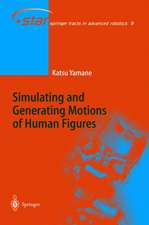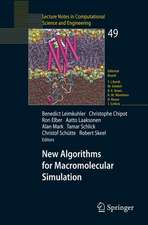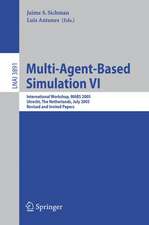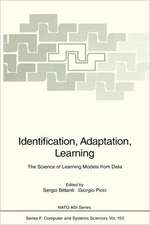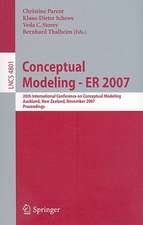Simulation by Bondgraphs: Introduction to a Graphical Method
Autor Jean U. Thomaen Limba Engleză Paperback – 8 dec 2011
Preț: 640.69 lei
Preț vechi: 800.86 lei
-20% Nou
Puncte Express: 961
Preț estimativ în valută:
122.59€ • 128.46$ • 101.35£
122.59€ • 128.46$ • 101.35£
Carte tipărită la comandă
Livrare economică 12-26 aprilie
Preluare comenzi: 021 569.72.76
Specificații
ISBN-13: 9783642839245
ISBN-10: 364283924X
Pagini: 200
Ilustrații: VIII, 188 p. 2 illus.
Dimensiuni: 155 x 235 x 11 mm
Greutate: 0.29 kg
Ediția:Softcover reprint of the original 1st ed. 1990
Editura: Springer Berlin, Heidelberg
Colecția Springer
Locul publicării:Berlin, Heidelberg, Germany
ISBN-10: 364283924X
Pagini: 200
Ilustrații: VIII, 188 p. 2 illus.
Dimensiuni: 155 x 235 x 11 mm
Greutate: 0.29 kg
Ediția:Softcover reprint of the original 1st ed. 1990
Editura: Springer Berlin, Heidelberg
Colecția Springer
Locul publicării:Berlin, Heidelberg, Germany
Public țintă
ResearchCuprins
1 Simulation and Graphical System Models.- 1.1 Setting the Stage.- 1.2 Networks for Engineering.- 1.3 Mixed Introductory Topics.- 2 Bondgraphs as Networks for Power and Signal Exchange.- 2.1 Word Bondgraphs and Main Bondgraph Variables.- 2.2 Bondgraph Standard Elements.- 2.3 Computation Marks, Power and Causality.- 2.4 Simulation from Blockdiagrams and Bondgraphs.- 2.5 Nonlinearities and Block-Bondgraphs.- 2.6 Multiport Bondgraph Elements.- 2.7 Junction Structures and Transformations.- 3 Simulation and Design of Mechanical Engineering Systems.- 3.1 Opening of the Application Chapters.- 3.2 Mechanical Systems with Ground Reference.- 3.3 Systematic Writing of Mechanical Bondgraphs with Moving Reference Points.- 3.4 Slip, Clutches and Electric Induction Motors.- 3.5 Transmissions and Efficiencies.- 4 Simulation of Fluid Power Systems and Hydrostatic Drives.- 4.1 Hydrostatic Power in Fluid Flow.- 4.2 Valve Controlled Actuators and Servomotors.- 4.3 Circuits and Hydrostatic Transmissions.- 4.4 Special Components and Devices.- 5 Electrical Circuits, Drives and Components.- 5.1 Electric Circuits and Components.- 5.2 Electric Motors.- 5.3 Capacitors, Inductors, Actuators and Real Transformers.- 6 Computational Overview, Practical Procedures and Problems.- 6.1 Programs for Simulation from a Bondgraph.- 6.2 Linear Control Theory, Eigenvalues and Calculating Step.- 6.3 Stability Preview and Steady State Bondgraphs.- 6.4 Eigenvalue Estimation and Dynacheck.- 6.5 Causality Problems and Algebraic Loops.- 6.6 Compact Parameters and Paracheck.- 6.7 Causal Loops and Inspectional Analysis.- 7 Applications to Thermodynamics, Chemistry and Biology.- 7.1 Meet and Love Entropy.- 7.2 Convection, Matter Flow and Solar Energy.- 7.3 Networks in Chemistry and Physics.- 8 Selected Questions.- 8.1Multibonds, Robotics and Circuit Theorems.- 8.2 Bondgraphs for Elements Distributed in Space.- 8.3 Shocks, Collisions and Hysteresis.- 8.4 Analogies, Linear Graphs and Portality.- 8.5 The Problem of Alternating Current Bondgraphs.- 9 Further Worked Examples.- 9.1 Hydraulic Examples.- 9.2 Thermofluid Examples.- Appendices.- A1 Organization of Bondgraph Courses.- A2 Note on Bondgraph Standards and Graphics.- A3 Table of the Main Bondgraph Elements.- Glossary of Frequent Terms in English, French, and German.- References.



